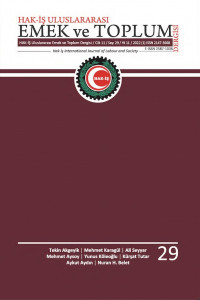“TOPLUM 5.0”DA BİLGİ VE İLETİŞİM TEKNOLOJİLERİ İLE YAŞLI BAKIMI
toplum 5.0, yaşlı bakımı, dijitalleşme süreci, sağlık/bakım sektörü, bakım teknolojileri.
CARE OF THE ELDERLY WITH INFORMATION AND COMMUNICATION TECHNOLOGIES IN "SOCIETY 5.0"
Society 5.0, process of digitalization, health/care sector, care of the elderly, care technologies.,
___
- Andreae, K. (2018). Gesellschaft 5.0 statt Industrie 4.0. 07.11. 2019 tarihinde https://www.fr.de/-meinung/gesellschaft-stattindustrie-1108930-2.html adresinden erişilmiştir.
- Berthold, K. (2019). Digitalisierung: Japan vernetzt sich zur Society 5.0. 09.10.2019 tarihinde https://logistikaktuell.com/2019/08/02/digitalisierung-society-5-0/ adresinden erişilmiştir.
- Capgemini/Prognos (2018). Gesellschaft 5.0. 05.10.2019 tarihinde https://www.prognos.com/uploads/tx_atwpubdb/ Prognos_Capgemini__Gesellschaft_5.0_Studie_1803.pdf adresinden erişilmiştir.
- Dahl, T.S. ve Boulos, M.N.K. (2013). Robots in health and social care: A complementary technology to home care and telehealthcare? Robotics. 3(1), 2–20.
- Daum, M. (2017). Digitalisierung und technisierung der pflege in Deutschland. Aktuelle trends und ihre folgewirkungen auf arbeitsorganisation, beschäftigung und qualifizierung. Hamburg: DAAStiftung Bildung und Beruf.
- Demirci, K. (2000). “Bir din olarak şintoizm'in gelişim süreci.” Dinler tarihi araştırmaları-II. Sempozyum: 20-21 Kasım 1998. Nr. 2. Konya: Dinler Tarihi Derneği Yayınları.
- Deutsche Stiftung Patientenschutz. (2018). Stellungnahme zur Anhörung „Pflegepersonalmangel in den Krankenhäusern und in der Altenpflege“ des Ausschusses für Gesundheit des Deutschen Bundestages am 18. April 2018 zu den Bundestagsdrucksachen 19/30, 19/79, 19/446 und 19/447. Dortmund: Patientenschutz Info-Dienst.
- Fuchs-Frohnhofen, P. vd. (2018). Memorandum: Arbeit und technik 4.0 in der professionellen pflege. Würselen: MA&T Sell & Partner.
- Hämel, K ve Schaeffer, D. (2013). Who cares? Fachkräftemangel in der Pflege. Zeitschrift für Sozialrefom, 59(4), 413–431.
- Hassemer, W. (2000). “Noch mal von vorn: Was bedeutet der kategorische Imperativ?” Die Zeit, 05.01.2000. 02/2000. 13.12.2019 tarihinde https://www.zeit.de/2000/02/NOCH_MAL_VON_VORN_WAS_ BEDEUTET_DER_KATEGORISCHE, adresinden erişilmiştir.
- Henzen, D. ve Sager, M. (2018). “Fördert Digitalisierung die Pflegeberufe?" Nr 5/2018. 10.10.2019 tarihinde https://alzheimer.ch/de/alltag/technische-hilfen/magazin-detail/373/foerdert-die-digitalisierungdie- pflegeberufe adresinden erişilmiştir.
- Hielscher, V. ve Kirchen-Peters, S. (2017). EDV-gestützte Dokumentation – wie wandelt sich die Pflegearbeit? QM-Praxis in der Pflege, 4, 28–30.
- Hielscher, V. (2014). Technikeinsatz und Arbeit in der Altenpflege. Ergebnisse einer internationalen Literaturrecherche. (Vol. 1). Institut für Sozialforschung und Sozialwirtschaft (iso) e. V., Saarbrücken: İSO- Report.
- Hößl, I. (2013). Sektorenübergreifende Kommunikation. Wie viel IT braucht die Pflege? Heilberufe/Das Pflegemagazin, 65(5), 24–26.
- Hübner, U. vd. (2015). IT-Report Gesundheitswesen. Schwerpunkt Pflege im Informationszeitalter. Hochschule Osnabrück: Forschungsgruppe Informatik im Gesundheitswesen (IGW).
- Klein, B. (2011). Technisierte Versorgung oder mehr Zeit für Kernaufgaben? Auswirkungen neuer Technologien auf die Pflegekräfte. Archiv für Wissenschaft und Praxis der sozialen Arbeit, 42(3), 87–97.
- Kroker, M. (2017). Industrie 4.0 – und Gesellschaft 5.0. 05.10.2019 tarihinde https://www.wiwo.de/technologie/digitalewelt/cebit-welcome-night-industrie-4-0-und-gesellschaft-5- 0/19541952.html adresinden erişilmiştir.
- Lobe, A. (2017). Japans smarte Utopie. 02.11.2019 tarihinde https://www.zeit.de/kultur/2017-04/japan- gesellschaft-zukunftautomatisierung-cebit adresinden erişilmiştir.
- Mildner, R. vd. (2017). Krankenhaus 4.0. Lübeck: UniTransferKlinik.
- Ploch, U. ve Werkmeister, T. (2017). Digitalisierung und Technisierung der Pflege in Deutschland. Aktuelle Trends und ihre Folgewirkungen auf Arbeitsorganisation, Beschäftigung und Qualifizierung. Hamburg: DAA- Stiftung Bildung und Beruf.
- Reker, J. ve Böhm, K. (2013). Digitalisierung im Mittelstand. 12.12.2019 tarihinde http://www2.deloitte.com/content/dam/Deloitte/de/Documents/Mittelstand/Digitalisierung-im- Mittelstand.pdf adresinden erişilmiştir.
- Rösler, U. vd., (2018). Digitalisierung in der Pflege. Wie intelligente Technologien die Arbeit professioneller Pflegender verändern. Berlin: Initiative Neue Qualität der Arbeit INQA.
- Seyyar, A. (2010). Tıbbî sosyal hizmetlerde manevî bakım. II. Genişletilmiş Baskı. İstanbul. Rağbet Yayınları.
- Seyyar, A. (2015). Hasta, engelli ve yaşlı hizmetlerinde bakım terimleri (Ansiklopedik Sözlük). İstanbul. Rağbet Yayınları.
- Simon, M. (2015). Unterbesetzung und Personalmehrbedarf im Pflegedienst der allgemeinen Krankenhäuser. Eine Schätzung auf Grundlage verfügbarer Daten. Hannover: Hochschule Hannover Fakultät V – Diakonie, Gesundheit und Soziales.
- Vincent, JL ve Creteur, J. (2017). The hospital of tomorrow in 10 points. Crit Care, 21(1), 93.
- Vogt, R. (01.03.2017). Japan: Auf dem Weg zur supersmarten Gesellschaft. 01.12.2019 tarihinde https://www.maschinenmarkt.vogel.de/japan-auf-dem-weg-zur-supersmarten-gesellschaft-a586100 adresinden erişilmiştir.
- Waldenberger, F. (2018). The Digital Future, Society 5.0: Japanese Ambitions and Initiatives. International Reports. 08.11.2019 tarihinde https://www.kas.de/documents/252038/253252/7_dokument_dok_pdf_52119_2.pdf/3b6a-8cd9-b41a- 3f5d-e6a6-220aa3572843?version=1.0&t=153964762-6138 adresinden erişilmiştir.
- ISSN: 2147-3668
- Başlangıç: 2012
- Yayıncı: Hak-İş (Hak İşçi Sendikaları Konfederasyonu)
İŞÇİLERİN SAHİP OLDUĞU İZİN HAKLARININ 4857 İŞ KANUNU BAKIMINDAN DEĞERLENDİRİLMESİ
“TOPLUM 5.0”DA BİLGİ VE İLETİŞİM TEKNOLOJİLERİ İLE YAŞLI BAKIMI
TÜRKİYE‘DE KADINLARIN İSTİHDAM EDİLMELERİNİ ZORLAŞTIRAN FAKTÖRLER
Seval ÖZTÜRK, Muhammed KARATAŞ
İŞÇİ SENDİKALARININ TOPLU İŞ SÖZLEŞMELERİNDE SOSYAL HİZMET UNSURLARININ İNCELENMESİ
ULUSLARARASI KURULUŞLAR AÇISINDAN KADININ GÜÇLENDİRİLMESİNE BAKIŞ
KARL MARX’IN DİN TOPLUM BAĞLAMINDAKİ ELEŞTİREL SOSYAL TEORİLERİNE İSLÂMÎ ELEŞTİRİ
Süleyman DİNÇER, Berk Can DAĞDELEN
NEOLİBERAL POLİTİKALAR BAĞLAMINDA GÖÇÜN VE YOKSULLUĞUN MEYDANA GETİRDİĞİ GÜVENCESİZLİK
